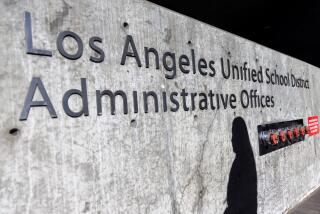Idled Scientists, Engineers to Be Retrained as Teachers : Education: U.S. to announce $5-million program for laid-off personnel. They would give math and science lessons in inner-city schools.
- Share via
In a program conceived as a national model, the U.S. Department of Defense will announce today a new $5-million program to retrain laid-off scientists and engineers for teaching careers in Los Angeles’ inner-city high schools.
The first 20 “teaching fellows” will be selected in the coming months and by summer should begin their studies--a specially tailored combination of classwork out of Cal State Long Beach and hands-on experience with mentor teachers in Los Angeles Unified School District. The trainees are expected to earn full credentials in time to start working as teachers in the fall of 1996.
Although some displaced defense industry workers have turned to teaching, occasionally supported by grants and programs, this is the largest commitment to date of government funding aimed at retraining for teaching careers in a specific district.
Organizers hope that the Scientists to Teachers Project will provide the seed for widespread improvement of math and science instruction in Los Angeles’ public schools.
“This is a lot more important than just producing some more teachers,” said Bruce M. Alberts, chairman of the National Research Council, a private nonprofit organization that will coordinate the program. “We hope (the fellows) will become leaders and advocates for science and math reform.”
Los Angeles was selected for the project because of its ready supply of laid-off aerospace, defense industry and military workers, because of the diversity of its student population and because the dearth of math and science teachers virtually ensures employment, Alberts said.
The project will cover all educational costs for the fellows and pay a $22,000 stipend during the instruction period. There is no requirement that the new teachers remain in the inner city. But the program will provide professional development and mentor activities for two additional years for those who stay.
Although Cal State Long Beach will be the site of the first year’s program, it may spread to other colleges and universities next year, when another 40 fellows are expected to be accepted.
Los Angeles Unified administrators greeted the project with enthusiasm and applauded the decision to focus on inner-city schools, where they find it especially difficult to recruit and retain well-qualified teachers.
“One of the major obstacles that we have is that there are not enough trained teachers in mathematics and sciences,” said Assistant Supt. Amelia McKenna. “Any avenue that will help us bring to the district people with this expertise is very attractive to us.”
Although strong in their knowledge of science and math, what the former professionals may lack is the ability to work well with teen-agers, McKenna said. To address that, project coordinators said they will look closely for applicants with attributes that might help the fellows thrive in public schools.
“Unquestionably they are very capable people, but they are not accustomed to the behavior of 10th-graders,” said Bob DeVries, director of a similar program at Cal State Dominguez Hills.
DeVries’ program began with financial support from four defense firms but is now funded through the Department of Labor as one of several options offered laid-off aerospace workers. Another national program, Troops to Teachers, focuses on getting retired military personnel into classrooms. Yet another provides educational support for ex-employees of the Lawrence Livermore Laboratories in Northern California who want to teach.
Harry Gray, a Caltech chemistry professor and chairman of the Scientists to Teachers advisory board, said the Los Angeles project should be viewed as an experiment, not a well-researched solution.
More to Read
Sign up for Essential California
The most important California stories and recommendations in your inbox every morning.
You may occasionally receive promotional content from the Los Angeles Times.













